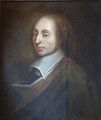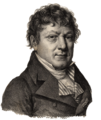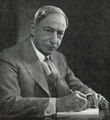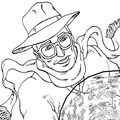Template:Selected anniversaries/August 19: Difference between revisions
No edit summary |
No edit summary |
||
| (6 intermediate revisions by the same user not shown) | |||
| Line 6: | Line 6: | ||
||1646: John Flamsteed born ... astronomer and academic. Pic. | ||1646: John Flamsteed born ... astronomer and academic. Pic. | ||
File:Blaise Pascal.jpg|link=Blaise Pascal (nonfiction)|1662: Mathematician, physicist, inventor, writer, and Christian philosopher [[Blaise Pascal (nonfiction)|Blaise Pascal]] dies. | File:Blaise Pascal.jpg|link=Blaise Pascal (nonfiction)|1662: Mathematician, physicist, inventor, writer, and Christian philosopher [[Blaise Pascal (nonfiction)|Blaise Pascal]] dies. Pacal did pioneering work on calculating machines. | ||
||1692: Salem witch trials: In Salem, Province of Massachusetts Bay, five people, one woman and four men, including a clergyman, are executed after being convicted of witchcraft. | ||1692: Salem witch trials: In Salem, Province of Massachusetts Bay, five people, one woman and four men, including a clergyman, are executed after being convicted of witchcraft. | ||
||1711: Soldier and industrialist Gabriel de Solages born. After serving in Italy, Germany and Bohemia he began exploiting coal mines on the family property near Carmaux in the Tarn department of southern France. To make use of surplus coal he opened a glass bottle factory and an iron works, and also opened a factory to make shipbuilding supplies. Pic. | |||
||1736: Erland Samuel Bring born ... mathematician. Pic. | ||1736: Erland Samuel Bring born ... mathematician. Pic. | ||
| Line 14: | Line 16: | ||
||1745: Johan Gottlieb Gahn born ... chemist and metallurgist who discovered manganese in 1774. Pic. | ||1745: Johan Gottlieb Gahn born ... chemist and metallurgist who discovered manganese in 1774. Pic. | ||
||1753: Johann Balthasar Neumann dies ... engineer and architect, designed Basilica of the Fourteen Holy Helpers. Pic search | ||1753: Johann Balthasar Neumann dies ... engineer and architect, designed Basilica of the Fourteen Holy Helpers. Pic search. | ||
File:Jean-Étienne Montucla.jpg|link=Jean-Étienne Montucla (nonfiction)|1758: [[Jean-Étienne Montucla (nonfiction)|Jean-Étienne Montucla]] received the censor's approbation for his ''Histoire des mathematiques'', which is justly famous as a history of the mathematical sciences. | File:Jean-Étienne Montucla.jpg|link=Jean-Étienne Montucla (nonfiction)|1758: [[Jean-Étienne Montucla (nonfiction)|Jean-Étienne Montucla]] received the censor's approbation for his ''Histoire des mathematiques'', which is justly famous as a history of the mathematical sciences. | ||
| Line 27: | Line 29: | ||
File:Jean Baptiste Joseph Delambre.png|link=Jean Baptiste Joseph Delambre (nonfiction)|1822: Mathematician and astronomer [[Jean Baptiste Joseph Delambre (nonfiction)|Jean Baptiste Joseph Delambre]] dies. He was one of the first astronomers to derive astronomical equations from analytical formulas. | File:Jean Baptiste Joseph Delambre.png|link=Jean Baptiste Joseph Delambre (nonfiction)|1822: Mathematician and astronomer [[Jean Baptiste Joseph Delambre (nonfiction)|Jean Baptiste Joseph Delambre]] dies. He was one of the first astronomers to derive astronomical equations from analytical formulas. | ||
||1830: Julius Lothar Meyer born ... chemist who discovered the Periodic Law, independently of Dmitry Mendeleyev, at about the same time (1869). However, he did not develop the periodic classification of the chemical elements as thoroughly as Mendeleyev. Meyer trained originally in medicine and chemistry. He examined the effect of carbon monoxide on blood. In 1879, Meyer compared atomic volume to atomic weight. Plotted on a graph, the curve showed the periodicity of the elements. He also established the concept of valency by indicating that a given element combined with a characteristic number of hydrogen atoms, and coined the terms like univalent, bivalent, and trivalent, based on that number. Pic. | ||1830: Julius Lothar Meyer born ... chemist who discovered the Periodic Law, independently of Dmitry Mendeleyev, at about the same time (1869). However, he did not develop the periodic classification of the chemical elements as thoroughly as Mendeleyev. Meyer trained originally in medicine and chemistry. He examined the effect of carbon monoxide on blood. In 1879, Meyer compared atomic volume to atomic weight. Plotted on a graph, the curve showed the periodicity of the elements. He also established the concept of valency by indicating that a given element combined with a characteristic number of hydrogen atoms, and coined the terms like univalent, bivalent, and trivalent, based on that number. Pic. | ||
| Line 52: | Line 52: | ||
||1888: Erik Edlund dies ... physicist. His scientific research was confined chiefly to the theory of electricity. He helped secure the introduction of weather stations to Sweden. | ||1888: Erik Edlund dies ... physicist. His scientific research was confined chiefly to the theory of electricity. He helped secure the introduction of weather stations to Sweden. | ||
||1891: Milton La Salle Humason born ... astronomer. He became known as a meticulous observer, obtaining photographs and difficult spectrograms of faint galaxies. His observations played a major role in the development of physical cosmology. Pic | ||1891: Milton La Salle Humason born ... astronomer. He became known as a meticulous observer, obtaining photographs and difficult spectrograms of faint galaxies. His observations played a major role in the development of physical cosmology. Pic search. | ||
||1897: Robert Brainard Corey born ... biochemist, mostly known for his role in discovery of the α-helix and the β-sheet with Linus Pauling. | ||1897: Robert Brainard Corey born ... biochemist, mostly known for his role in discovery of the α-helix and the β-sheet with Linus Pauling. Pic search. | ||
File:Philo T Farnsworth.jpg|link=Philo Farnsworth (nonfiction)|1906: Inventor [[Philo Farnsworth (nonfiction)|Philo Farnsworth]] born. He will make many crucial contributions to the early development of all-electronic television. | File:Philo T Farnsworth.jpg|link=Philo Farnsworth (nonfiction)|1906: Inventor [[Philo Farnsworth (nonfiction)|Philo Farnsworth]] born. He will make many crucial contributions to the early development of all-electronic television. | ||
||1909: Joseph Gilbert Hoffman born ... physicist and biophysicist who brought atomic isotopes into the battle against cancer. During WW II, he developed a radio proximity fuse and later was a health-physics scientist with "Manhattan Project." Hoffman studied nine accident victims of radiation disease at Los Alamos in Aug 1945 and May 1946. This research revealed for the first time that atoms of living human tissue could be transformed into radioactive atoms. He recognized "a completely new approach to studying the metabolism of atoms in living tissue and a new way of probing the complicated system of gene cells that determine heredity," and such knowledge was indispensable to understanding the mysteries of cancer research in which he engaged for the rest of his life. Pic | ||1909: Joseph Gilbert Hoffman born ... physicist and biophysicist who brought atomic isotopes into the battle against cancer. During WW II, he developed a radio proximity fuse and later was a health-physics scientist with "Manhattan Project." Hoffman studied nine accident victims of radiation disease at Los Alamos in Aug 1945 and May 1946. This research revealed for the first time that atoms of living human tissue could be transformed into radioactive atoms. He recognized "a completely new approach to studying the metabolism of atoms in living tissue and a new way of probing the complicated system of gene cells that determine heredity," and such knowledge was indispensable to understanding the mysteries of cancer research in which he engaged for the rest of his life. Pic search. | ||
File:John Hadji Argyris.jpg|link=John Argyris (nonfiction)|1913: Computer scientist, engineer, and academic [[John Argyris (nonfiction)|John Argyris]] born. A pioneer of computer applications in science and engineering, Argyris will be among the creators of the finite element method. | File:John Hadji Argyris.jpg|link=John Argyris (nonfiction)|1913: Computer scientist, engineer, and academic [[John Argyris (nonfiction)|John Argyris]] born. A pioneer of computer applications in science and engineering, Argyris will be among the creators of the finite element method. | ||
| Line 68: | Line 68: | ||
||1924: Willard Boyle born ... physicist and academic, Nobel Prize laureate ... pioneer in the field of laser technology and co-inventor of the charge-coupled device. Pic. | ||1924: Willard Boyle born ... physicist and academic, Nobel Prize laureate ... pioneer in the field of laser technology and co-inventor of the charge-coupled device. Pic. | ||
||1926: George Daniels born ... horologist who was considered to be the best in the world during his lifetime. He was one of the few modern watchmakers who built complete watches by hand (including the case and dial). But it was his creation of the coaxial escapement for which he is most remembered. The movement, which removed the need to add a lubricant, has been used by Omega in their highest-grade watches since 1999. Pic. | ||1926: George Daniels born ... horologist who was considered to be the best in the world during his lifetime. He was one of the few modern watchmakers who built complete watches by hand (including the case and dial). But it was his creation of the coaxial escapement for which he is most remembered. The movement, which removed the need to add a lubricant, has been used by Omega in their highest-grade watches since 1999. Pic search. | ||
||1931: Aristides Agramonte y Simoni dies ... pathologist and bacteriologist who was a member of the Reed Yellow Fever Board of the U.S. Army that discovered (1901) the role of the mosquito in the transmission of yellow fever. In May 1898, he was appointed Acting Assistant Surgeon in the U.S. Army. Agramonte had acquired immunity to yellow fever from a mild childhood case in Cuba before emigrating to the U.S., which was an advantage when he was chosen by the Surgeon-General to study the yellow fever outbreak in General Shafter's army in Cuba. There Agramonte performed autopsies in order to determine the causative agent of the disease. After additional work in Cuba, in May 1900, Agramonte was appointmented to Walter Reed's Yellow Fever Commission. Pic. | ||1931: Aristides Agramonte y Simoni dies ... pathologist and bacteriologist who was a member of the Reed Yellow Fever Board of the U.S. Army that discovered (1901) the role of the mosquito in the transmission of yellow fever. In May 1898, he was appointed Acting Assistant Surgeon in the U.S. Army. Agramonte had acquired immunity to yellow fever from a mild childhood case in Cuba before emigrating to the U.S., which was an advantage when he was chosen by the Surgeon-General to study the yellow fever outbreak in General Shafter's army in Cuba. There Agramonte performed autopsies in order to determine the causative agent of the disease. After additional work in Cuba, in May 1900, Agramonte was appointmented to Walter Reed's Yellow Fever Commission. Pic. | ||
| Line 77: | Line 77: | ||
||1943: The Quebec Agreement signed ... was an agreement between the United Kingdom and the United States outlining the terms for the coordinated development of the science and engineering related to nuclear energy, and, specifically nuclear weapons. It was signed by Winston Churchill and Franklin D. Roosevelt on 19 August 1943, during World War II, at the Quadrant Conference in Quebec City, Quebec, Canada. Pic (to exploit). | ||1943: The Quebec Agreement signed ... was an agreement between the United Kingdom and the United States outlining the terms for the coordinated development of the science and engineering related to nuclear energy, and, specifically nuclear weapons. It was signed by Winston Churchill and Franklin D. Roosevelt on 19 August 1943, during World War II, at the Quadrant Conference in Quebec City, Quebec, Canada. Pic (to exploit). | ||
||1947: Paul Callaghan born ... physicist and academic. Callaghan's research group specialized in developing NMR methodologies for the study of molecular dynamics and molecular organisation in complex fluids, soft matter and porous materials. Pic search. | |||
||1947: The first full synthesis route for vitamin A was found by Dutch chemists, Jozef Ferdinand Arens and David Adriaan van Dorp. Later in 1947, a team headed by O. Isler also synthesized vitamin A using a method more suitable to produce commerical quantities. | ||1947: The first full synthesis route for vitamin A was found by Dutch chemists, Jozef Ferdinand Arens and David Adriaan van Dorp. Later in 1947, a team headed by O. Isler also synthesized vitamin A using a method more suitable to produce commerical quantities. | ||
||1950: Giovanni Giorgi dies ... physicist and engineer. | ||1950: Giovanni Giorgi dies ... physicist and engineer. Pic. | ||
||1953: The CIA and MI6 help to overthrow the government of Mohammad Mosaddegh in Iran and reinstate the Shah Mohammad Reza Pahlavi. | ||1953: The CIA and MI6 help to overthrow the government of Mohammad Mosaddegh in Iran and reinstate the Shah Mohammad Reza Pahlavi. | ||
||1957: Carl-Gustaf Rossby dies ... meteorologist who first explained the large-scale motions of the atmosphere in terms of fluid mechanics. His work contributed to developing meteorology as a science. Rossby first theorized about the existence of the jet stream in 1939, and that it governs the easterly movement of most weather. U.S. Army Air Corps pilots flying B-29 bombing missions across the Pacific Ocean during World War II proved the jet stream's existence. The pilots found that when they flew from east to west, they experienced slower arrival times and fuel shortage problems. When flying from west to east, however, they found the opposite to be true. Rossby created mathematical models (Rossby equations) for computerized weather prediction (1950). Pic. | ||1957: Carl-Gustaf Rossby dies ... meteorologist who first explained the large-scale motions of the atmosphere in terms of fluid mechanics. His work contributed to developing meteorology as a science. Rossby first theorized about the existence of the jet stream in 1939, and that it governs the easterly movement of most weather. U.S. Army Air Corps pilots flying B-29 bombing missions across the Pacific Ocean during World War II proved the jet stream's existence. The pilots found that when they flew from east to west, they experienced slower arrival times and fuel shortage problems. When flying from west to east, however, they found the opposite to be true. Rossby created mathematical models (Rossby equations) for computerized weather prediction (1950). Pic search. | ||
||1960: In Moscow, Russia, Soviet Union, downed American U-2 pilot Francis Gary Powers is sentenced to ten years imprisonment by the Soviet Union for espionage. | ||1960: In Moscow, Russia, Soviet Union, downed American U-2 pilot Francis Gary Powers is sentenced to ten years imprisonment by the Soviet Union for espionage. | ||
| Line 92: | Line 94: | ||
||1960, the first commercial atomic energy reactor, and the third in the U.S., achieved a self-sustaining nuclear reaction. It began producing power for distribution on 10 Nov 1960. This was the $57 million Yankee Atomic Electric Company's plant at Rowe, Mass., on the Deerfield River. The pressurized light-water reactor produced 125,000 kilowatts of electricity. The company was formed by twelve New England utility companies which signed a contract with the Westinghouse Corporation as the principal contractor. It was permanently shut down on 26 Feb 1992, due to reactor vessel embrittlement, after more than 31 years of service. Decommissioning began in 1993. | ||1960, the first commercial atomic energy reactor, and the third in the U.S., achieved a self-sustaining nuclear reaction. It began producing power for distribution on 10 Nov 1960. This was the $57 million Yankee Atomic Electric Company's plant at Rowe, Mass., on the Deerfield River. The pressurized light-water reactor produced 125,000 kilowatts of electricity. The company was formed by twelve New England utility companies which signed a contract with the Westinghouse Corporation as the principal contractor. It was permanently shut down on 26 Feb 1992, due to reactor vessel embrittlement, after more than 31 years of service. Decommissioning began in 1993. | ||
||1964: Hans Peter Luhn dies ... researcher in the field of computer science, and, Library & Information Science for IBM, and creator of the Luhn algorithm, KWIC (Key Words In Context) indexing, and Selective dissemination of information ("SDI"). Pic search | ||1964: Hans Peter Luhn dies ... researcher in the field of computer science, and, Library & Information Science for IBM, and creator of the Luhn algorithm, KWIC (Key Words In Context) indexing, and Selective dissemination of information ("SDI"). Pic search. | ||
||1964: Syncom 3, the first geostationary communication satellite, is launched. | ||1964: Syncom 3, the first geostationary communication satellite, is launched. | ||
| Line 117: | Line 119: | ||
File:Giant Red Ball in Toledo Ohio.jpg|link=Toledo giant red ball incident (nonfiction)|2015: A [[Toledo giant red ball incident (nonfiction)|giant red ball breaks loose from an art installation and rolls down the street]] in Toledo, Ohio. | File:Giant Red Ball in Toledo Ohio.jpg|link=Toledo giant red ball incident (nonfiction)|2015: A [[Toledo giant red ball incident (nonfiction)|giant red ball breaks loose from an art installation and rolls down the street]] in Toledo, Ohio. | ||
</gallery> | </gallery> | ||
Latest revision as of 12:12, 7 February 2022
1662: Mathematician, physicist, inventor, writer, and Christian philosopher Blaise Pascal dies. Pacal did pioneering work on calculating machines.
1758: Jean-Étienne Montucla received the censor's approbation for his Histoire des mathematiques, which is justly famous as a history of the mathematical sciences.
1822: Mathematician and astronomer Jean Baptiste Joseph Delambre dies. He was one of the first astronomers to derive astronomical equations from analytical formulas.
1906: Inventor Philo Farnsworth born. He will make many crucial contributions to the early development of all-electronic television.
1913: Computer scientist, engineer, and academic John Argyris born. A pioneer of computer applications in science and engineering, Argyris will be among the creators of the finite element method.
1923: Engineer, sociologist, economist, political scientist, and philosopher Vilfredo Pareto dies. He applied mathematics to economic analysis, asserting that the distribution of incomes and wealth in society is not random and that a consistent pattern appears throughout history, in all parts of the world and in all societies.
1967: Inventor, writer, editor, and publisher Hugo Gernsback dies. He published the first science fiction magazine, and had a profound influence on the development of science fiction.
1993: Actor-cryptographer Niles Cartouchian confirms that he personally designed the computational security protocols featured in the action-adventure film Dard Hunter, Glyph Warden.
1994: Chemist, biochemist, peace activist, author, and educator Linus Pauling dies.
2015: A giant red ball breaks loose from an art installation and rolls down the street in Toledo, Ohio.









